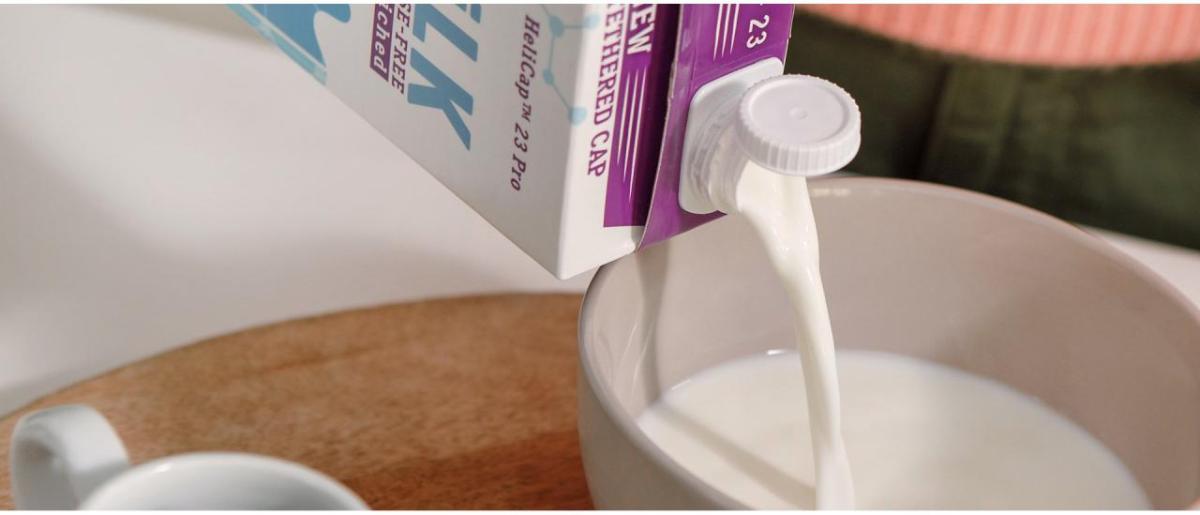Meeting EU Regulations Head-On
Compliance doesn’t have to limit progress – it can also be an opportunity for growth and innovation
“The Single-Use Plastic Directive is unprecedented,” explains Riccardo Vellani, Product Director for Additional Materials at Tetra Pak.
In June 2019, the European Union (EU) passed the Single-Use Plastic Directive, banning several single-use items, such as cotton bud sticks, cutlery, plates and straws.
Since then, the list has grown, and from July 2024, all beverage packages, excluding glass and metal, must be sold with tethered caps, opening devices designed to stay attached to the packaging to help prevent plastic litter.
When the directive was announced, little was known about tethered caps. How compatible would they be with existing packaging, and what would it cost to retrofit – or even upgrade – equipment?
“Consumers in the EU are completely unaware of the coming legislation, so companies need to explain the importance – and the benefits – of tethered caps to consumers”
“Many of our customers have several production lines, so it was crucial to minimise the impact of a new solution on their operations to ensure a smooth transition. At the same time, we also saw an opportunity to rethink our solutions. If we’re going to change things, we have to look at what we can improve,” says Riccardo.
How do you make a solution for half a billion people?
8 different tethered cap concepts went into development simultaneously to deliver a solution that could fit more than half a billion consumers in more than 25 countries.
“We’ve managed to reduce the plastic content in most of the solutions released so far* and focus on consumer convenience, making packages easy to open and close. We want to make the caps available with as many of our solutions as possible – most recently, we added the TwistCapTM OSO 34 Pro for Tetra Rex® carton packages – and the caps are also available in a plant-based version. We’ve also made sure that any changes haven’t impacted shelf life or product safety,” says Riccardo.
The close collaboration with customers paid off: In early 2021, the first tethered caps were ready to be introduced to the world. Since then, things have moved quickly, and just recently, Tetra Pak reached a milestone with over 3 billion tethered caps delivered to customers.
The industry is leading the way when it comes to explaining why to consumers
“Consumers in the EU are completely unaware of the coming legislation. Just like with the introduction of paper straws, companies need to explain the importance – and the benefits – of tethered caps to consumers,” says Riccardo. And usually, that involves a certain amount of convincing as consumers often start out with a big ‘Why?’.
“It’s difficult to connect a seemingly small change like caps to the bigger and more complex journey towards sustainable packaging and reduced littering.”
To support our customers, we’ve developed communication materials that can help them successfully communicate about the transition to tethered caps.
“The new caps offer many benefits that consumers respond positively to once they understand the reasons behind their development. They don’t realise that, in many cases, they’re going from using a two-step opening, where you either unscrew the lid and lift the pull-ring or twist the lid and pull a tab, to a new one-step opening solution. Consumers have different habits and it takes time to get used to new solutions. Especially if we’re talking about daily routines, such as opening a carton of milk or putting your favourite juice in the backpack,” says Riccardo.
Tethered caps have potential beyond EU directives – and borders
With over 3 billion tethered caps now delivered to customers, what’s next?
“We’ll continue to work closely with our customers, so we’re prepared for new regulations or initiatives. Because if it impacts our customers, it impacts us. We want to help them stay ahead of the game.”
Beyond the EU, there’s also potential for tethered caps in other geographies.
“Tethered caps are not yet required by legislation in other markets, but I think people are seeing how they can play a role when it comes to litter reduction. So, we’re looking into expanding the offering, delivering them as new, improved one-step openings with environmental benefits,” concludes Riccardo.
* The reduction of plastic content by weight is as follows:
- HeliCap™ 26 Pro: 13% compared to HeliCap™ 27
- DreamCap™ 26 Pro: 7% compared to the existing DreamCap™ 26
- LightWing™ 30: 12%* compared to the existing WingCap™ 30 closure (liner excluded from the calculation)
“The new caps offer many benefits that consumers respond positively to once they understand the reasons behind their development. But it takes time to get used to new solutions and change daily routines, such as opening a carton of milk or putting your favourite juice in the backpack”



